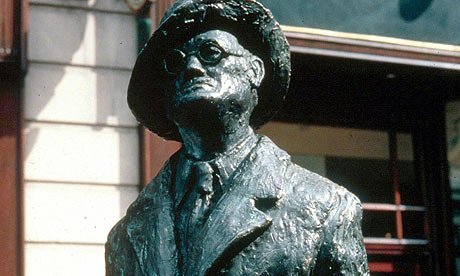 |
| James Joyce |
A brief survey of the short story part 32:
James Joyce
With just one collection of stories, Joyce left his mark on almost every short story writer who followed him

James Joyce statue In Dublin. Photograph: George Sweeney/Rex Features
James Joyce wrote just one collection of short stories, but it ranks among the finest in world literature. His influence on the form is as great as that of his near-contemporary Anton Chekhov. Between them their innovations – informed most discernibly, in Joyce's case, by Ibsen, French symbolist poetry and the Irishman George Moore – have influenced nigh-on every short story writer of the last 100 years.
Dubliners, a work of what Terence Brown has called "embryonic modernism", pushed the short story collection into new areas. Its 15 stories function perfectly well in isolation, but reading each as part of a whole creates unique effects. Their themes, concerns and meanings overlap and reverberate. Most obviously, all 15 stories take place in Dublin. Secondly, they are ordered so that the book charts life "under", as Joyce explained, "four of its aspects: childhood, adolescence, maturity and public life." From this grounding, a range of experience is explored: love, marriage, employment, politics, religion and death. Deeper within this superstructure subtler patterns occur; concealed associations that might or might not be detected by the reader: Joyce's signposting is subtle, often to the point of obscurity.
Joyce called these stories "epiclets". He wrote them in Dublin, Zurich, Pola, Rome and Trieste between 1903 and 1907, but publishers' concerns about their content meant Dubliners didn't appear until 1914. Discussing the stories in letters, Joyce wrote that "My intention was to write a chapter of the moral history of my country and I chose Dublin for the scene because that city seemed to me the centre of paralysis."
For Joyce, "paralysis" represents a moral failure resulting in the inability to live meaningfully. It appears on the first page of the first story, "Two Sisters", in a sentence that offers a key to the whole book:
"Every night as I gazed up at the window I said softly to myself the word paralysis. It had always sounded strangely in my ears, like the word gnomon in the Euclid and the word Simony in the Catechism."
Here the "paralysis" is both literal, in the case of a dying priest after his third stroke, and moral: "simony" takes aim at the Catholic church's corrupting stranglehold on Irish society (culminating in the gleefully satirical Grace); "gnomon" is somewhat different, being more about form than content (a gnomon is a parallelogram with a section removed, as well as the shadow-casting part of a sundial). The word is a cryptic warning to the reader that these stories contain many absences, not least traditional plot, character and scene-setting.
These absences are part of what Joyce referred to as the style of "scrupulous meanness" with which he wrote Dubliners, meaning the frugality he applies to language, image and emotion. The approach has since become a type. As Joyce Carol Oates has said, "the Joycean short story is immediately recognisable as a sub-genre in which the directness of the prose and the suggestive ellipsis of poetry are blended". Few, however, can achieve what Joyce did with such sparseness. In Dubliners, as Lance St John Butler says, "the line from linguistic detail to narrative meaning is direct ... form is content; the language and even the grammar of Dubliners are the stories' meaning."
Through his language, most notably his mastery of free indirect style, which confers the intimacy and inflection of first-person storytelling on third-person narration, Joyce subtly lays the ground for each "epiphany": the moment, towards which each of these stories build, when pointlessness gathers itself, however briefly, into something revelatory. The most famous of these comes at the end of "The Dead", when Gabriel Conroy envisions the snow that is falling all across Ireland that night. This moment underlines Dubliners' unique unity as a collection: read alone, as Florence L Walzl has noted, Gabriel's epiphany seems something like "redemption". Succeeding the 14 previous stories, however it is more "a recognition that he is a dead member of a dead society". Indeed, with the line "the snow falling faintly through the universe ... upon all the living and the dead", Joyce performs a stunning inversion: now the frustrated, egotistical Gabriel is "dead", and dead Michael Furey, who loved Gabriel's wife, lives on in memory.
It is no coincidence that this complexly patterned sequence should begin and end with stories – "Two Sisters" and "The Dead" – that have interchangeable titles. Their endings are twinned, too. As David G Wright says: "[Two Sisters] begins with a boy standing in the street, looking through a dimly lighted window and imagining the death of the man inside, while 'The Dead' ends with a man looking out through a window towards a dim light from the street, reflecting on human mortality in general and on the account of a particular dead boy which his wife has just related to him." Having ranged across the city and its suburbs, Dubliners' opening and closing scenes take place just a street away from each other: like the circular wandering of the swindler Lenehan in "Two Gallants", our journey through the paralytic stasis of Dublin leaves us – physically, if not intellectually or emotionally – right where we began.




No comments:
Post a Comment